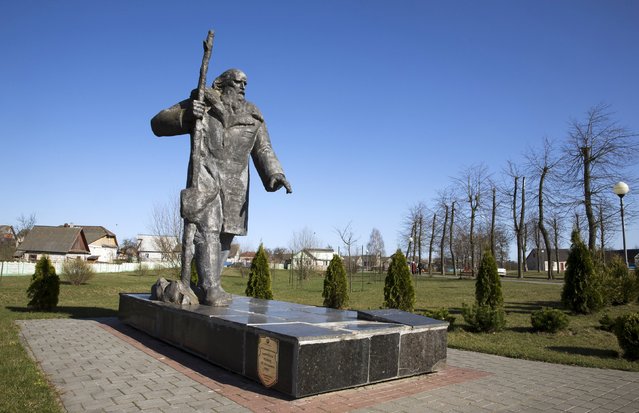
A girl poses for a photo as she stands on a T-34 tank, a World War Two monument, in the town of Bobruisk, southeast of Minsk, March 7, 2015. Belarus will mark Victory Day on May 9, the 70th anniversary of the Soviet Union's victory over Nazi Germany. (Photo by Vasily Fedosenko/Reuters)

A monument dedicated to the World War Two victims is seen at a mass grave in the village of Novaelnia, southwest of Minsk, March 30, 2015. According to the inscriptions on the monument, 23 Soviet soldiers, officers and villagers buried at this site were killed during the war. (Photo by Vasily Fedosenko/Reuters)

A World War Two memorial is seen in the former village of Khatyn, northeast of Minsk, March 22, 2015. Nazi troops killed 149 villagers on March 22, 1943, most of them children and women, and burned down their houses and the village was never restored again, according to historians. (Photo by Vasily Fedosenko/Reuters)

Employees work to restore the Mount of Glory, dedicated to World War Two, near the village of Sloboda, east of Minsk, April 26, 2015. (Photo by Vasily Fedosenko/Reuters)

The “Yama” (Pit) memorial is seen in the centre of Minsk May 5, 2015. The memorial is dedicated of the destruction of the Minsk ghetto during World War Two, when several hundred thousands of Jews were slaughtered. (Photo by Vasily Fedosenko/Reuters)

A monument with portraits of soldiers killed during World War Two is seen in the village of Sychkovo, southeast of Minsk, March 11, 2015. According to the inscriptions on the monument, 230 Soviet soldiers and officers killed during the war were buried at this site. (Photo by Vasily Fedosenko/Reuters)

A monument dedicated to the World War Two victims is seen at a mass grave in the village of Iatoltovichi, west of Minsk, March 29, 2015. Nazi troops killed 96 villagers on February 22, 1943, in this village, according to the inscription on the monument. (Photo by Vasily Fedosenko/Reuters)

People visit the “Stalin Line” memorial, where collected samples of military equipment from the time of the World War Two to the present day are displayed, near the village of Goroshki, west of Minsk, May 5, 2015. (Photo by Vasily Fedosenko/Reuters)

A monument dedicated to villager Iosif Filidovich is seen in the town of Diatlovo, southwest of Minsk, April 11, 2015. Filidovich, according to the inscription on the monument, in December 1942 lured Germany soldiers into the marshes and woods, promising to show them the way to partizan's base and was killed after that. (Photo by Vasily Fedosenko/Reuters)

A part of the “Stalin Line” memorial, where collected samples of military equipment from the time of the World War Two to the present day are displayed, is seen near the village of Goroshki, west of Minsk, May 5, 2015. (Photo by Vasily Fedosenko/Reuters)

A monument dedicated to villagers killed during World War Two is seen in the abandoned village of Orevichi, in the exclusion zone around the Chernobyl nuclear reactor, southeast of Minsk, April 21, 2015. (Photo by Vasily Fedosenko/Reuters)

An employee works to restore the Mount of Glory, dedicated to World War Two, near the village of Sloboda, east of Minsk, April 26, 2015. (Photo by Vasily Fedosenko/Reuters)

Victory Square, dedicated to World War Two, is seen in Minsk, December 20, 2014. (Photo by Vasily Fedosenko/Reuters)

A man visits a monument, dedicated to the Polish and Belarussian people killed during World War Two, near the village of Pererov, southwest of Minsk, April 17, 2015. (Photo by Vasily Fedosenko/Reuters)

A memorial dedicated to 11 Soviet soldiers killed during the World War Two is seen in Minsk, May 5, 2015. (Photo by Vasily Fedosenko/Reuters)

A man stands at the monument of Soviet leader Joseph Stalin at the “Stalin Line” memorial, near the village of Goroshki, west of Minsk, May 5, 2015. (Photo by Vasily Fedosenko/Reuters)

People walk at the “Brest Hero-Fortress” memorial complex in Brest April 27, 2015. (Photo by Vasily Fedosenko/Reuters)
07 May 2015 12:38:00,
post received
0 comments
